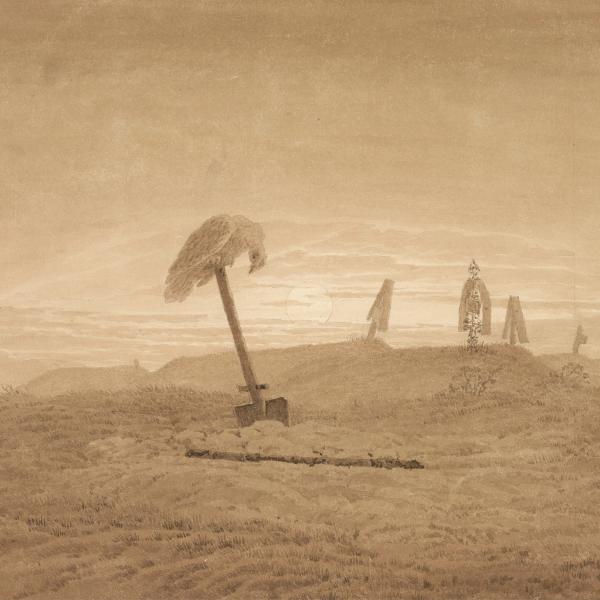Cemetery Landscape with a Vulture
Artwork Details
- Title: Cemetery Landscape with a Vulture
- Artist: Caspar David Friedrich (German, Greifswald 1774–1840 Dresden)
- Date: ca. 1834
- Medium: Brown ink and wash with pencil on wove paper (framing lines in black ink)
- Dimensions: 9 3/8 × 11 1/4 in. (23.8 × 28.6 cm)
Framed: 16 5/8 in. × 18 3/8 in. × 1 1/2 in. (42.2 × 46.7 × 3.8 cm) - Classification: Drawings
- Credit Line: The Albertina Museum, Vienna (24610)
- Curatorial Department: European Paintings
Audio

380. The Great Beyond
How did Friedrich picture transcendence in his late works?
NARRATOR: Caspar David Friedrich passed away in 1840 at the age of sixty-five. In the last five years of his life, he returned to the same materials with which he began his career, three decades earlier.
JOANNA SHEERS SEIDENSTEIN: Why he does this is not certain, but he does effectively create this kind of coda.
NARRATOR: Co-curator of the exhibition, Joanna Sheers Seidenstein.
SHEERS SEIDENSTEIN: He returns to ink and wash as a primary creative vehicle, but also revisiting motifs and subjects that he had depicted earlier in his career: cemeteries, graveyards, tombs of different kinds, or the seashore.
As an aging artist, as a person who has suffered a stroke, certainly thinking about his own mortality as a kind of existential philosophical question, he’s pouring all of that into his work in these late years. And so, there's a spiritual quality, a kind of remarkable sense of calm.
And I think at the same time he is as ambitious as ever, and an artist who never really stops, whose artistic drive and his enthusiasm for art making never diminishes.
ALUA ARTHUR: The body does what it can do for the time that it can do it, and when it can’t do it anymore, it stops.
NARRATOR: Death Doula, Alua Arthur.
ARTHUR: There is an utter perfection in how it all works. And when I can surrender to the perfection that exists in nature, I can also surrender to the perfection that exists in the timing of my life and my death. Much like I trust nature, I am nature.
ANDREA WULF: Earth is not kind of dead. It's not like a rock or a stone. It’s all connected and it’s all alive.
NARRATOR: Romantic historian, Andrea Wulf.
WULF: There’s one breath that is pulled out over everything from one pole to another pole, which is in rocks and insects and in plants and animals. And this is this kind of life force. And it’s not a divine force, it is a life force.
JORDAN B. COOPER: This kind of trinity of God, nature, and beauty. All of these three realities all kind of come together and coalesce in that experience that one has of nature.
NARRATOR: Lutheran pastor, Jordan B. Cooper.
COOPER: When you are out in the midst of the beauty of the natural world, and there you experience God, and there you have that experience of beauty.
ALISON HOKANSON: Some artists find their spirituality in nature or in the representation of nature.
NARRATOR: Co-curator, Alison Hokanson.
HOKANSON: And I think for us today, perhaps the tendency is often to embrace the secular side of that imagery, which was indeed something that existed at the time. But for certain viewers, and I think Friedrich himself as an artist, I think the takeaway there is this search for spirituality, the search for redemption, the search for solace and consolation to be living through.
NARRATOR: Thank you for visiting Caspar David Friedrich: The Soul of Nature. May these works offer you a moment to slow down, look closely, and take in the beauty around you.
This audio guide was produced by SOUND MADE PUBLIC in collaboration with The Metropolitan Museum of Art.
This audio guide is sponsored by Bloomberg Philanthropies.
###
Music: Beethoven, Piano Sonata No.14 in C-Sharp Minor, Op. 272, Moonlight Sonata